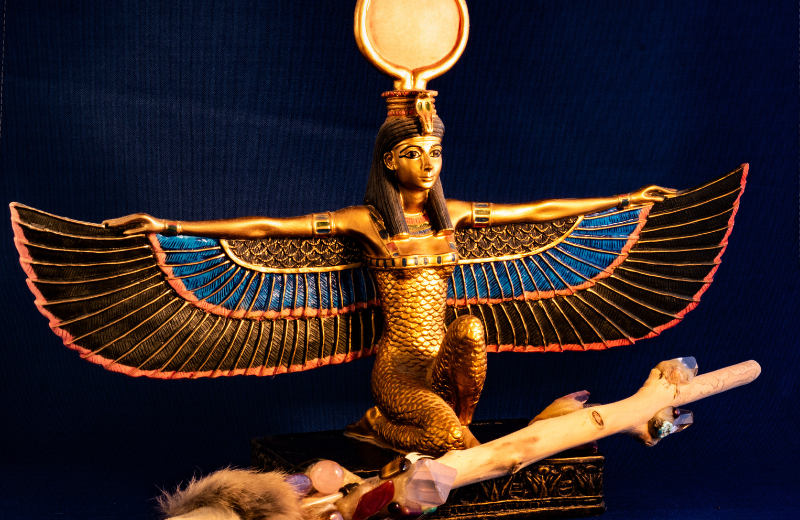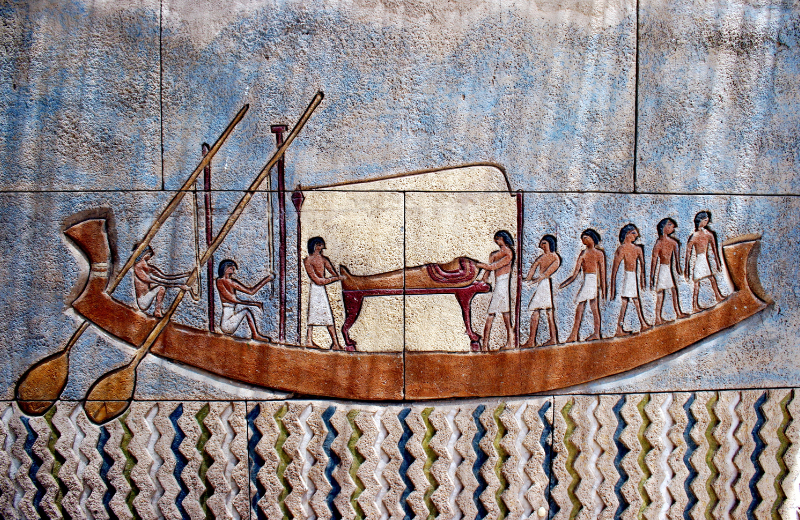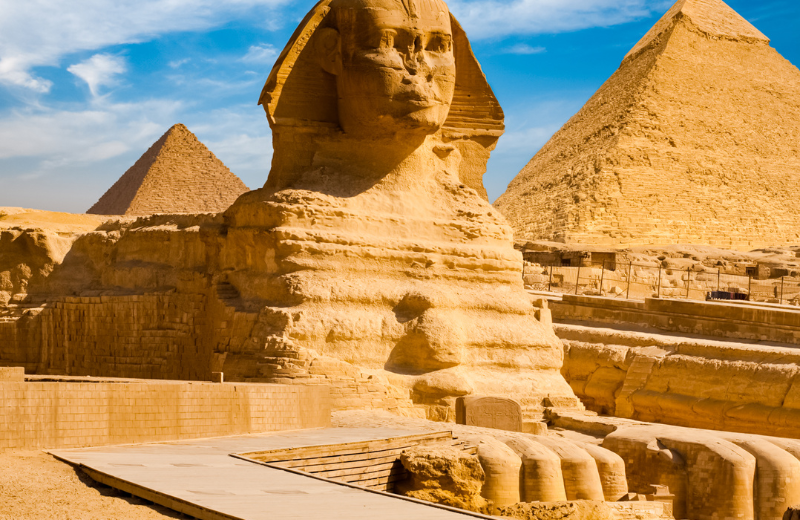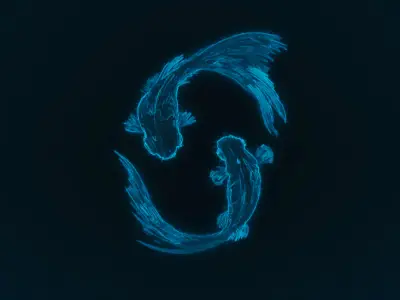As the Egyptian goddess of truth, justice, and cosmic order, Ma'at played a central role in ancient Egyptian belief systems, and her principles were foundational to their society. Let’s explore the myths, symbols, and powers associated with Ma'at.
Jump to:
Recommended for you!
Best SellersWho is Ma'at in Egyptian Mythology?

Ma'at, also spelled Maat, is the goddess of truth, justice, and cosmic order in Egyptian mythology. She’s depicted as a woman with an ostrich feather on her head, symbolising her integral role in maintaining balance and harmony in the universe. Ma'at is not just a deity; she represents the very principles that ensured the stability and prosperity of ancient Egyptian society.
What is Ma'at the God of?
Ma'at is the goddess of truth, justice, and the cosmic order. Her essence is embedded in the concepts of balance and harmony, governing both the natural world and human society. She embodies the moral and ethical standards that were expected of every individual in ancient Egypt, from the common person to the pharaoh.
The Myths and Legends of Ma'at
Ma'at features in many stories of ancient Egyptian mythology, reflecting her significance in maintaining cosmic and societal order. These myths highlight her influence and the values she represents, from guiding the sun god Ra to judging the souls of the deceased.
Ma'at and Ra: The Guiding Light
In Egyptian mythology, Ma'at is often described as the daughter of the sun god Ra. Each morning, Ra would rise in the east, guided by Ma'at to bring light and order to the world. Ma'at’s presence ensured that Ra’s journey across the sky was smooth and uninterrupted, symbolising the harmony and balance she maintained in the universe. Without Ma'at, Ra’s journey would be fraught with chaos and darkness, disrupting the natural order.
The Weighing of the Heart Ceremony
One of the most significant myths involving Ma'at is the weighing of the heart ceremony in the afterlife. In this ceremony, the heart of the deceased is weighed against Ma'at's feather of truth. If the heart is lighter or equal in weight, the soul is granted access to the afterlife. If it is heavier, indicating a life of wrongdoing, the heart is devoured by the demon Ammit, resulting in eternal damnation. This myth underscores the importance of living a life in accordance with Ma'at's principles of truth and justice.
Ma'at and the Judgement of Osiris
Another notable myth is the judgement of Osiris, the god of the afterlife. Ma'at plays a role in this story as she presides over the judgement of souls alongside Osiris. When the deceased enter the Hall of Ma'at, they must declare their innocence of 42 sins, known as the negative confessions. Ma'at ensures that these declarations are truthful. This process reinforces the idea that living in alignment with Ma'at’s principles is essential for achieving a favourable judgement in the afterlife.
Ma'at and the Maintenance of Cosmic Order
Ma'at's influence extends beyond the human realm into the cosmic. She’s believed to be the force that maintains the stars in their courses, the seasons in their cycles, and the balance between the gods. According to mythology, Ma'at’s principles ensure that the universe functions smoothly. This myth highlights her overarching role in sustaining the natural and divine order, which is essential for the stability of the cosmos.
The Tale of the Two Brothers: Ma'at and Bata
In the tale of the two brothers, Anpu and Bata, Ma'at's principles are central to the story’s resolution. After being falsely accused of a crime by his brother Anpu's wife, Bata invokes Ma'at’s principles to prove his innocence. Through a series of divine interventions, the truth is revealed, and justice is served, reflecting Ma'at's power in upholding truth and fairness even in human affairs. This myth demonstrates how Ma'at's influence permeates all levels of existence, from divine to mortal realms.
The Symbols of Ma'at
Ma'at's symbols are powerful representations of her role in maintaining cosmic order and justice. Each symbol carries deep significance and highlights different aspects of her responsibilities.
- Ostrich Feather: The most prominent symbol of Ma'at is the ostrich feather, which she wears on her head. This feather represents truth, balance, and justice. It’s used in the weighing of the heart ceremony, symbolising the standard against which the righteousness of individuals is measured.
- Scales: Another significant symbol is the scales. During the weighing of the heart ceremony, the scales are used to balance the heart of the deceased against Ma'at's feather.
- Ankh: Ma'at is sometimes depicted holding an ankh, the symbol of life. This connection highlights her role in upholding the life-giving order of the universe, ensuring that life proceeds in harmony with divine principles.
- Sceptre: Ma'at is also shown holding a sceptre, a symbol of authority. This emphasises her power to enforce the laws of truth and justice, maintaining order in both the natural and human worlds.
What Powers Does Ma'at Have?

Ma'at’s powers are essential in upholding the principles of truth, justice, and cosmic order. Her influence extends to various aspects of life, ensuring the smooth and just operation of both the natural and human worlds.
- Upholding Truth and Justice: Ma'at has the power to maintain truth and justice, guiding people to act ethically and fairly. Her principles are the foundation of moral and legal codes, ensuring that society functions harmoniously.
- Preventing Chaos (Isfet): By embodying the principles of Ma'at, people help prevent chaos, known as Isfet, from disrupting the balance of the universe. Ma'at’s presence ensures that order prevails, keeping the forces of chaos at bay.
- Guiding the Sun God Ra: Ma'at plays a role in guiding Ra, the sun god, on his daily journey across the sky. This guidance ensures that light and order are brought to the world each day, symbolising the ongoing struggle between order and chaos.
- Judging Souls in the Afterlife: Ma'at’s power is important in the afterlife, where she oversees the weighing of the heart ceremony. Her feather of truth determines the fate of souls, ensuring that only the righteous are granted eternal life.
- Influencing Governance and Law: Pharaohs and leaders are seen as earthly embodiments of Ma'at, responsible for ruling in accordance with her principles. This influence ensures that governance and law are aligned with the values of truth, justice, and balance.
Ma'at's Relationships, Children, and Family Tree
Ma'at's relationships and family connections highlight her integral role in maintaining the cosmic and moral order.
- Daughter of Ra: Ma'at is often regarded as the daughter of Ra, the sun god. This relationship highlights her importance in the sun's daily cycle and the maintenance of cosmic order, as she ensures Ra's journey across the sky is smooth and uninterrupted.
- Association with Thoth: Ma'at is also sometimes associated with Thoth, the god of wisdom, writing, and knowledge. Thoth upheld Ma'at's principles through his role as the divine scribe, recording the deeds of humans and the gods alike. Their association reinforces the connection between truth, justice, and knowledge.
- Influence on Other Gods and Mortals: While Ma'at is not typically noted for having children, her influence permeates through the actions and principles of other gods and mortals. Her principles are embodied by those who seek to live in truth and uphold justice, making her an essential part of the ethical and moral fabric of ancient Egyptian society.
Ma'at's Worship and Legacy

The worship of Ma'at was central to ancient Egyptian society, reflecting her enduring legacy of maintaining order and justice.
Pharaohs as Embodiments of Ma'at
Pharaohs were seen as the earthly embodiments of Ma'at, responsible for ruling in accordance with her principles. This expectation ensured that Egypt's leadership was aligned with the values of truth, justice, and balance, critical for the stability of the kingdom.
Temples and Shrines
Temples and shrines dedicated to Ma'at were common, and her ideals were deeply embedded in the laws and moral codes of the time. These sacred spaces provided a place for people to honour Ma'at and seek her guidance in maintaining harmony in their lives.
Ma'at's Enduring Legacy
Ma'at's legacy continues to be felt today, as her concepts of truth, justice, and order resonate with many modern-day ethical and legal systems. The principles she embodied remain relevant, highlighting the timeless nature of her influence on human society.
Statues and Depictions
Statues and depictions of Ma'at have been discovered throughout Egypt, often in temple settings and on tomb walls. These images typically show her with the ostrich feather on her head, representing her domain over truth and justice. The unique artistry of these depictions underscores her importance in the cosmic balance and her role in the afterlife.
Making Offerings to Ma'at
To honour Ma'at, ancient Egyptians made various offerings to invoke her protection and blessings. These offerings often included food, drink, and symbolic items such as small statues or amulets. Common offerings included bread, beer, and water, reflecting Ma'at’s role in sustaining life and maintaining order.
In modern times, those who feel a connection to Ma'at might offer symbols of truth and justice, such as feathers, scales, or candles. Creating a small altar with images of Ma'at, along with symbols of balance and fairness, is a way to connect with her enduring principles.
Recommended for you!
Best SellersFrequently Asked Questions About Ma'at
Who is the male version of Ma'at?
There isn't a direct male counterpart to Ma'at, but the god Thoth, who is associated with wisdom, writing, and knowledge, often works closely with Ma'at in maintaining order and justice.
Why does Ma'at have wings?
Ma'at is sometimes depicted with wings to symbolise her all-encompassing presence and her ability to reach and influence all parts of the universe, ensuring that her principles of truth and justice are upheld everywhere.
What is the Egyptian code of Ma'at?
The Egyptian code of Ma'at refers to the ethical and moral guidelines that were expected to be followed by all individuals. These principles, which included truth, justice, and balance, were the foundation of both personal conduct and state governance.
What is the Greek equivalent of Ma'at?
The Greek equivalent of Ma'at is Themis, the goddess of divine law and order. Both deities share similar roles in their respective mythologies, embodying justice, order, and balance.
What is another name for Ma'at?
Ma'at is also simply known as Maat. Her name encapsulates her essence and principles, and there are no other widely recognised names for her.
What is the weakness of the goddess Ma'at?
As a deity embodying ideals rather than physical prowess, Ma'at’s "weakness" could be seen as the perpetual challenge of upholding truth and justice in a world where chaos and disorder (Isfet) constantly threaten to disrupt balance.
Who is the opposite of Ma'at?
The opposite of Ma'at is Isfet, which represents chaos, disorder, and injustice. Isfet is the force that Ma'at constantly battles to maintain harmony and balance in the universe.
What is the order of Ma'at?
The order of Ma'at refers to the natural and societal order that Ma'at maintains. This order is crucial for the stability and prosperity of the world and encompasses everything from the cycles of nature to the moral conduct of individuals.
What is Ma'at called in English?
In English, Ma'at is usually referred to simply as Ma'at or Maat. There is no direct English translation that fully captures the depth of her principles, though "truth" and "justice" are closely related concepts.
What animal is associated with Ma'at?
While Ma'at herself is not directly associated with any specific animal, the ostrich feather, a part of an ostrich, is her most prominent symbol. The feather represents truth, balance, and justice.
Study Egyptian Mythology for £29
If you’ve enjoyed learning about Ma'at and her significance in ancient Egyptian mythology, Centre of Excellence offers an Egyptian Mythology Diploma Course that covers Ma'at and many more deities. This course is perfect for anyone looking to expand their knowledge and understanding of ancient Egyptian culture and mythology. For a limited time, you can enrol for a discounted price of £29!













